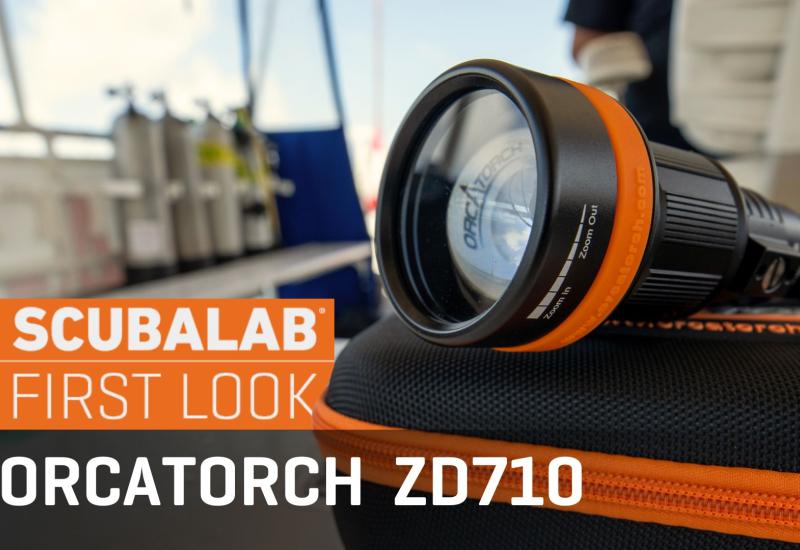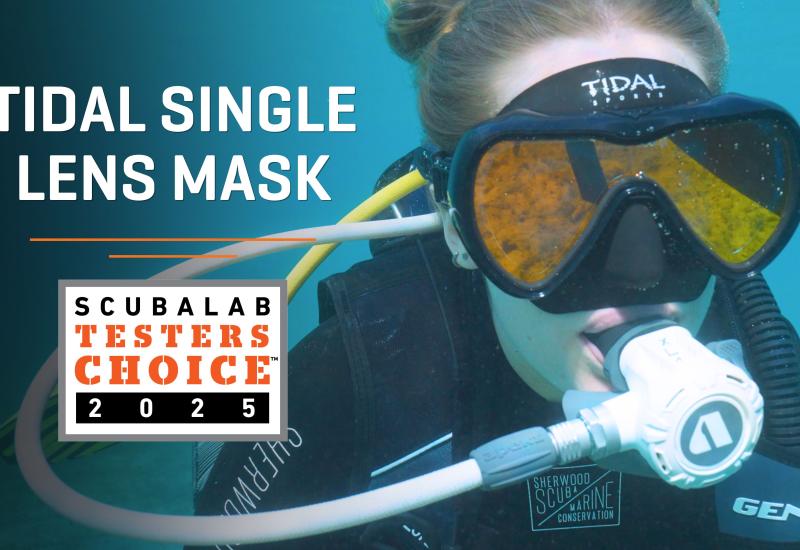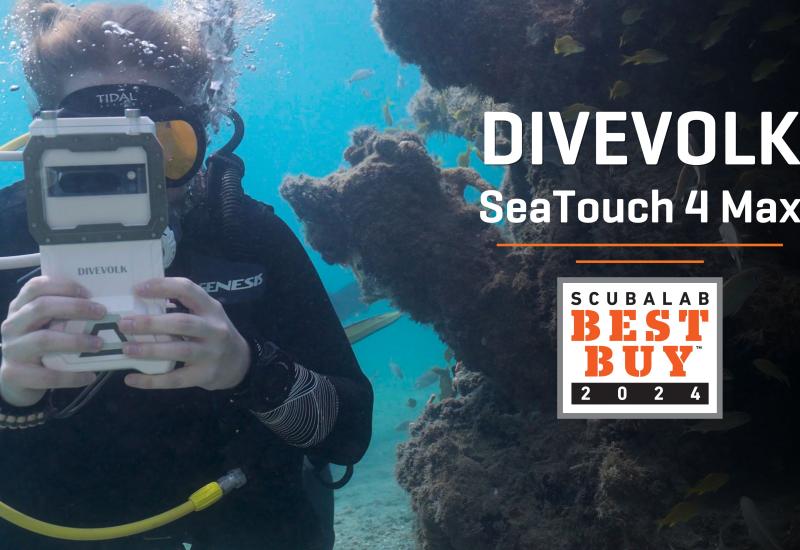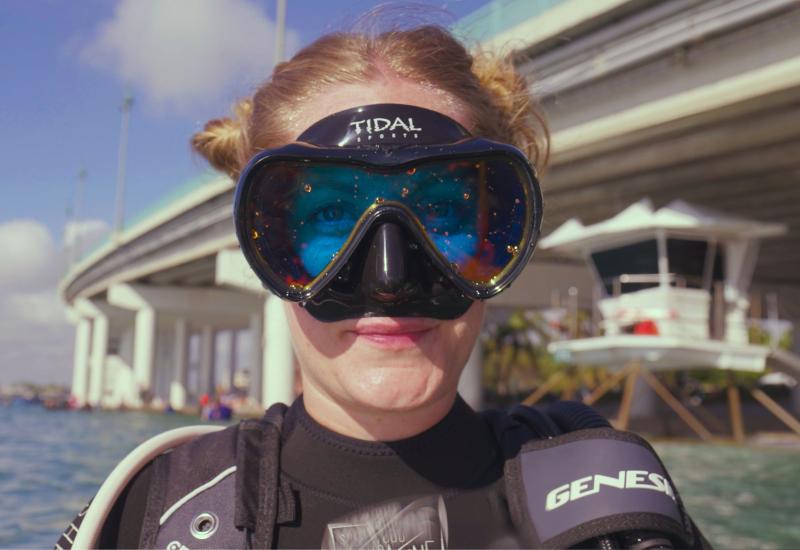Emergency Signaling Gear Tested and Reviewed By ScubaLab
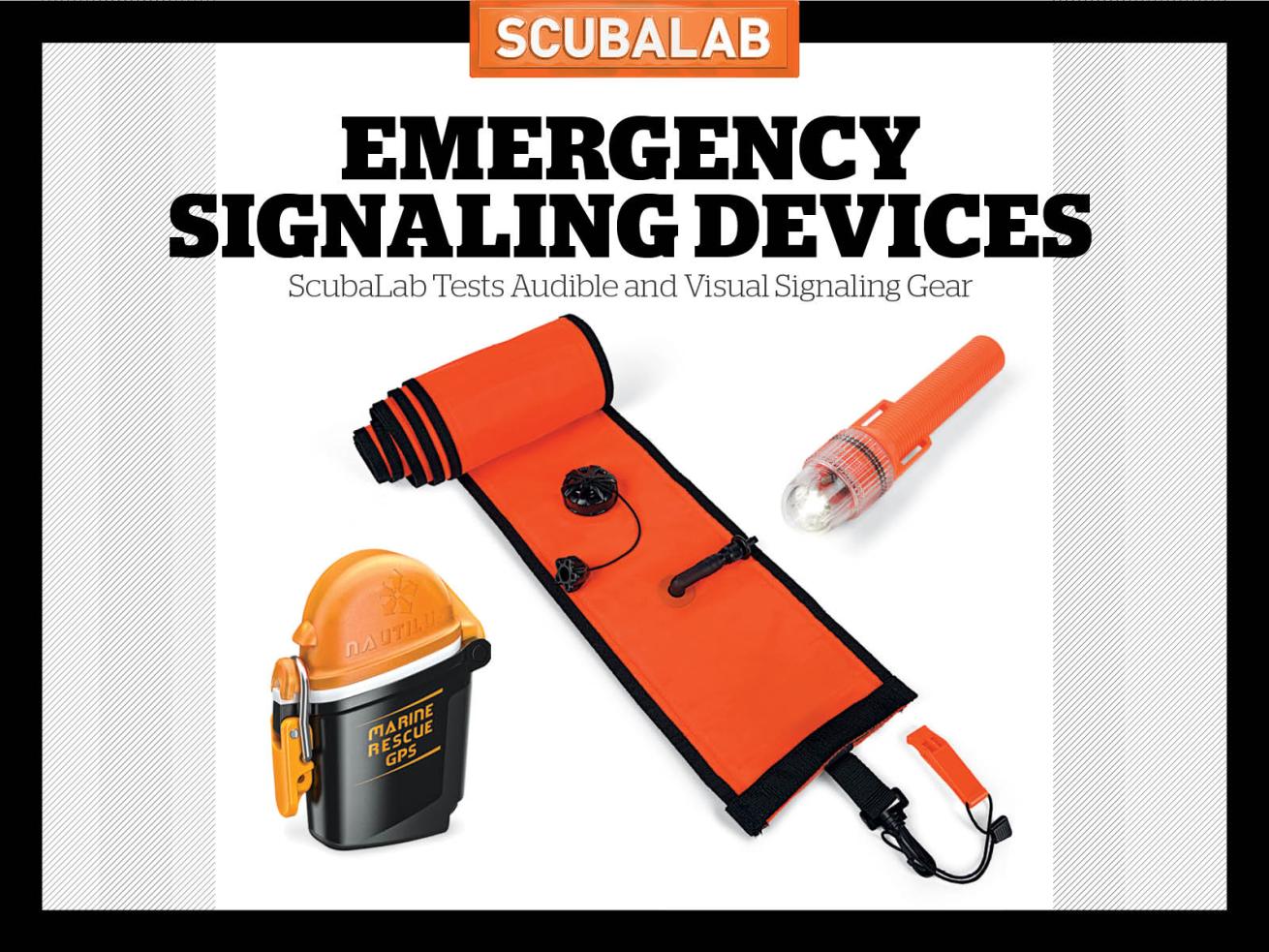
Jon WhittleBe seen and heard with this selection of visual and audible signaling gear.
If you're separated from the boat while scuba diving, getting attention can be a matter of life and death. ScubaLab evaluated a selection of the latest emergency signaling devices to see how they perform.
CHECK OUT ALL OF SCUBALAB'S GEAR REVIEWS
How We Test
We assembled a variety of signaling gear to gauge relative performance.
For SMBs and similar devices, we tested a range from the largest available to the smallest deemed practical, and we tested several types of lights in different sizes and outputs.
Our aim was to simulate conditions of a scuba diver in the water being viewed from someone on a small boat in moderate sea conditions. We conducted our test at Sebastian Inlet State Park on Florida’s Atlantic coast — an arrow-straight strip of beach where we could gauge visibility over an unobstructed line of sight, with the observer about 6 feet higher in elevation on the beach than the “diver” and with water and surf in the background.
We tested at distances of a half-mile and 1 mile. These distances were chosen based on math and case histories. In 30 minutes, a 1-knot current can transport a scuba diver more than a half-mile, and a 2-knot current nearly 1.25 miles. Our review of a sampling of Coast Guard accounts of missing searches found many instances of divers who separated at much greater distances.
In the reviews below are details about our perception of the visibility and audibility of the devices we tried. It’s important to note that the performance of each device was highly dependent on the conditions, particularly time of day, light intensity and angle, visual background and sea state, but we made some general observations:
Even small SMBs were more visible than a diver with no signaling device. But it was more difficult than expected to spot even the largest devices at our test distances, though we consider our test conditions — clear weather and a “searcher” on stable ground who knows where to look — a best-case scenario.
By twilight, the lights we tested were far easier to spot than even the most visible SMBs had been in daylight; the brightest was visible for miles. Flashing lights weren’t particularly more noticeable than non-flashing, but a benefit of a flash mode is that it dramatically increases battery life.
What Was The Most Effective Signaling Device?
Even more so than most dive gear, the answer depends on the conditions. A visual device that’s terrific in clear weather isn’t much use in heavy fog, and a light that’s not really visible in bright sun is effective once the sun drops. Our test underscored the importance of being prepared — in equipment and training — for the emergencies you might face.
Nautilus Marine Rescue GPS
Price: $199 | Contact: nautiluslifeline.com
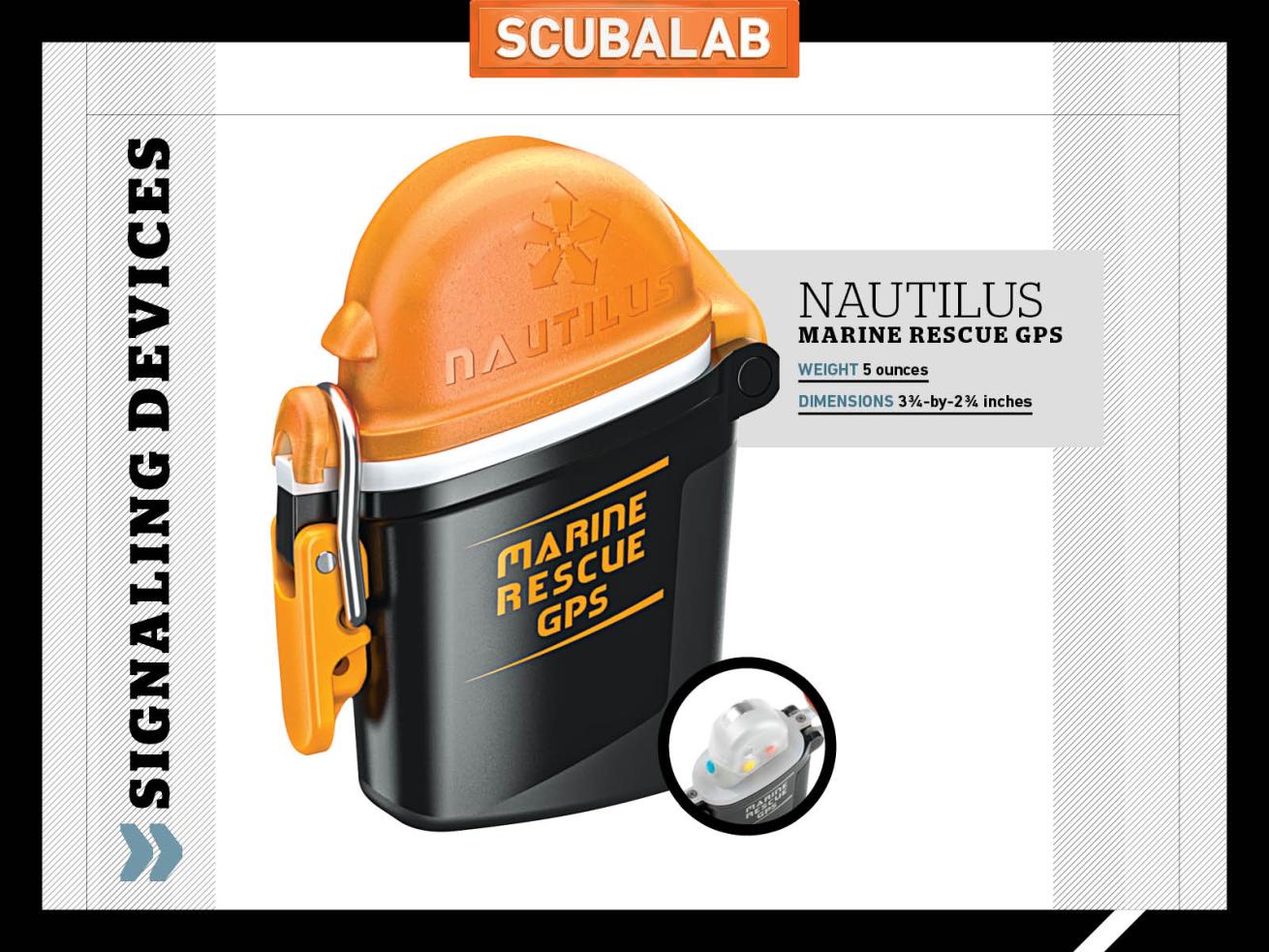
Courtesy Nautilus, Jon WhittleNautilus Marine Rescue GPS
The Nautilus GPS will broadcast a digital "man-overboard" signal with your GPS coordinates up to 34 miles.
The latest version of this VHF transmitter (the previous version was called LifeLine) is only half the size of the original Nautilus GPS. More changes are under the hood: simplified operation, user-replaceable batteries, and no need to register it before use. Waterproof to 425 feet when closed, the new Nautilus Marine Rescue GPS has a streamlined operation: Open the cap, press the blue button, pop off the retainer to unfurl the 9-inch antenna, and hold the red button for five seconds. The Nautilus GPS will broadcast a digital “man overboard” signal with your GPS coordinates to any boat with a VHF radio equipped with the marine Automatic Identification System — required for most cargo ships and all passenger-carrying vessels (and, hopefully, standard equipment on any boat you’re diving from). Nautilus says the 1-watt radio will transmit the emergency signal up to 34 miles.
DiveAlert Plus V.2
Price: $88.84 | Contact: divealert.com
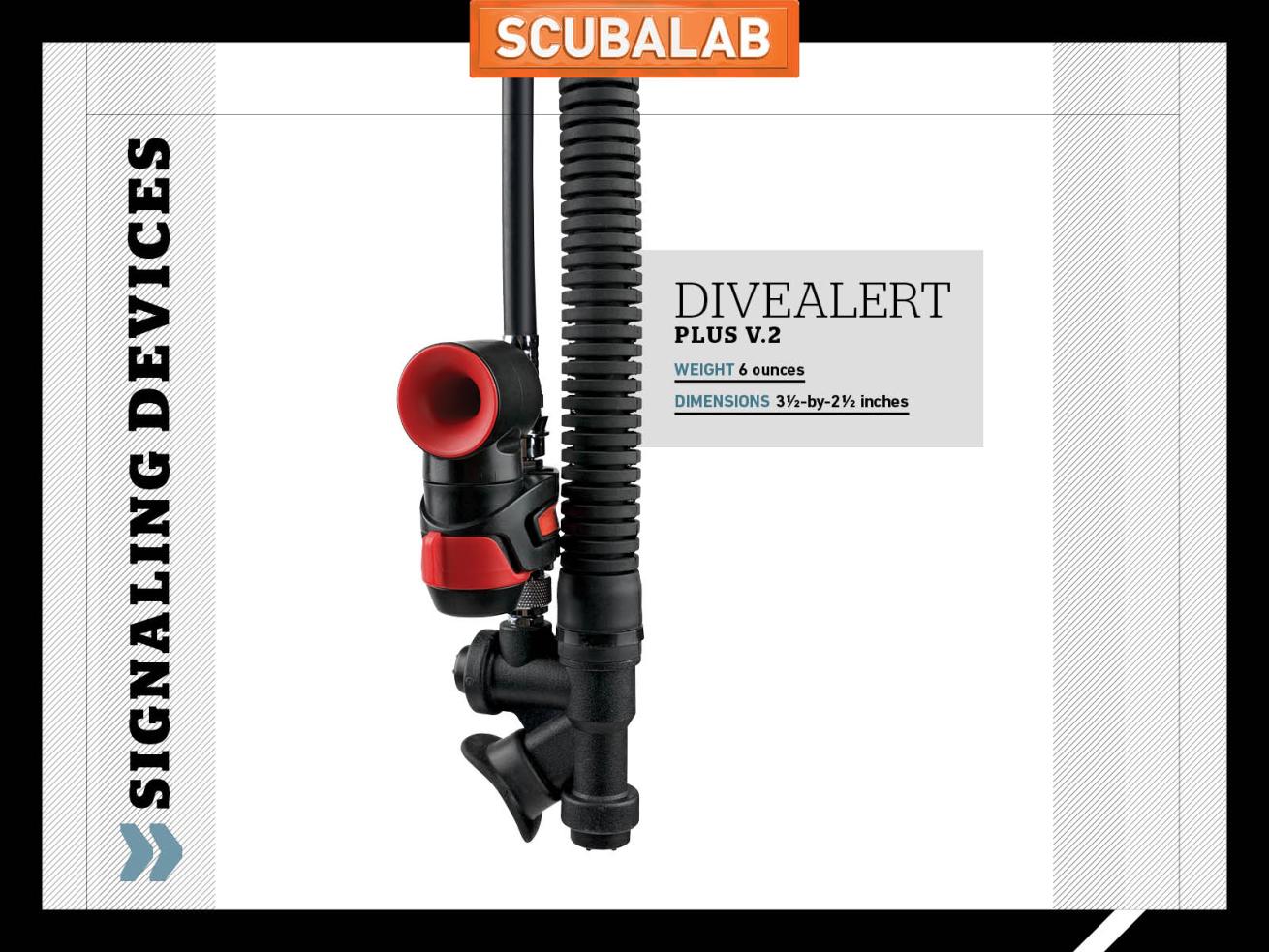
Jon WhittleDive Alert Plus V.2
The Dive Alert Plus is easy to install, this tank-powered air horn clips in between your hose and power inflator.
Basically an air horn, the DiveAlert Plus clips in between the hose and power inflator (with models that also work with combo octo/power inflators). It installs in two seconds and is small enough you don’t notice it when scuba diving. In our test, the DiveAlert was aimed in our general direction, but our test site was relatively noisy, with a steady surf and a brisk onshore breeze blowing against the DiveAlert. Even so, its foghornlike honk was clearly audible from a mile away. Up close it’s painfully loud; thankfully there’s a lock to prevent accidental alarms. It needs air to work, but it makes as much noise with a nearly empty tank as one that’s full, and will work until tank pressure falls too low for your reg to deliver air.
DiveAlert SMB
Price: $66 | Contact: divealert.com
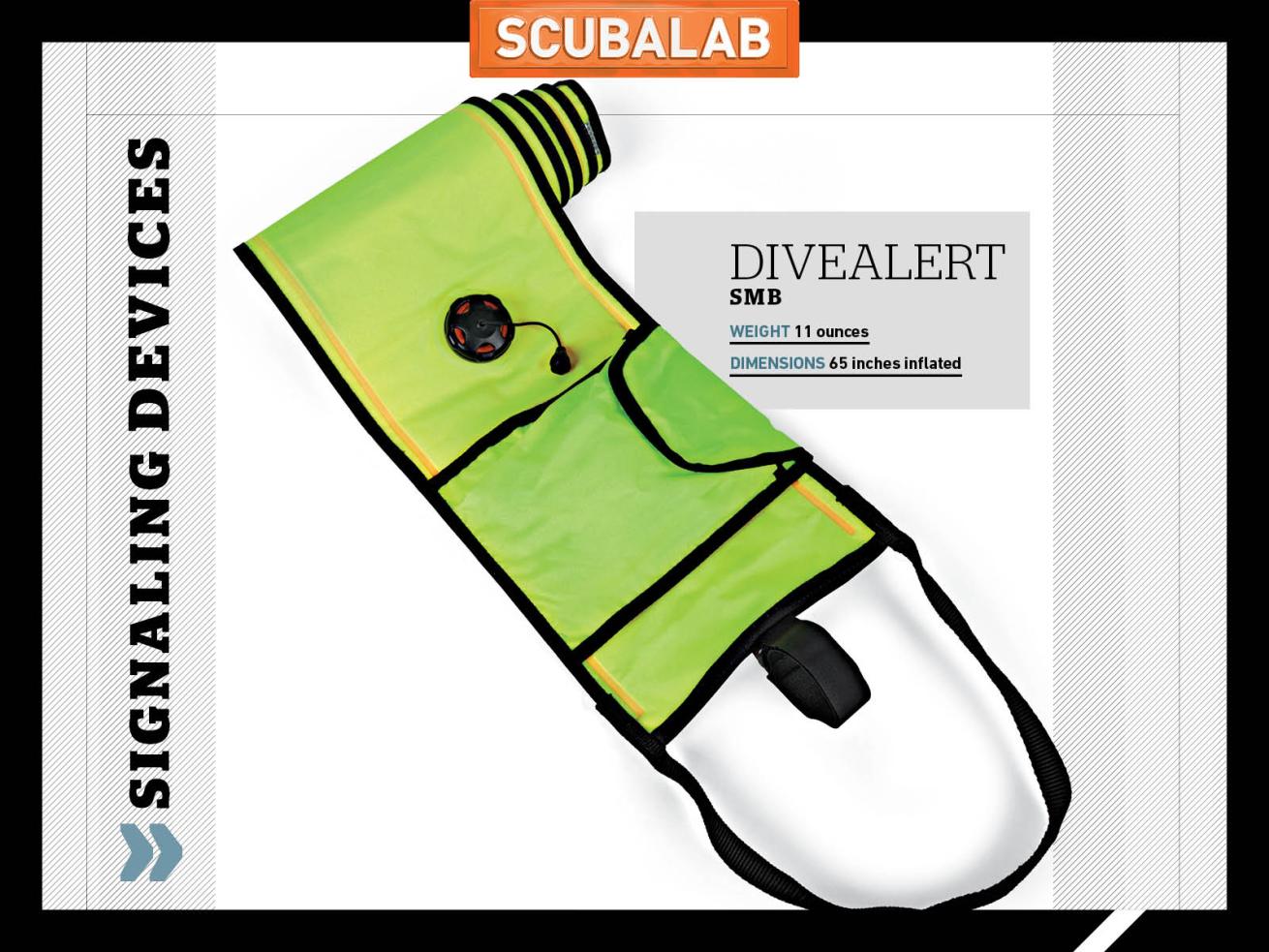
Jon WhittleDiveAlert SMB
This SMB from DiveAlert has two differently colored sides — one yellow an one orange — two provide you with a visible signaling solution in a variety of environments.
This tube addresses the which-color-is-better debate by splitting the difference, with one side orange and one yellow. At a mile out, neither side was easily visible to the naked eye, although the tube is 8½ inches wide uninflated, the widest here. At a half-mile, it was easily visible — but only the orange, because in our test conditions, the yellow was lost in the bright sun and surfy background. But certainly the yellow would be more visible in other conditions — such as lower light and with a darker background — and the dual-color design is a clever way to hedge your bets.
SeaLife Sea Dragon 2500
Price: $499 (including tray and grip) | Contact: sealife-cameras.com
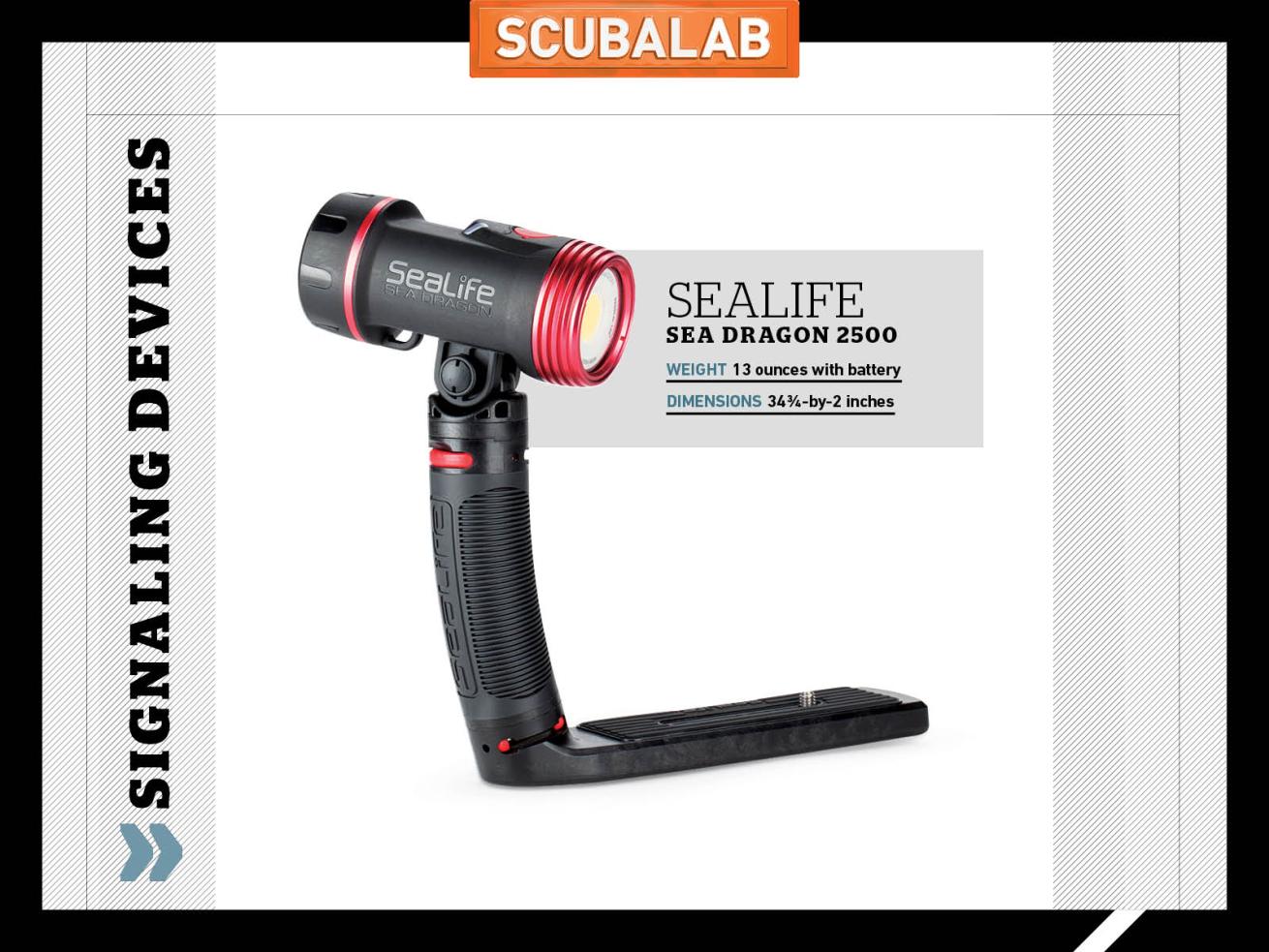
Jon WhittleSeaLife Sea Dragon 2500
The SeaLife Sea Dragon 2500 shows that even an underwater photo/video light can be useful in an emergency situation.
If size matters for SMBs, do lumens matter for dive lights? To find out, we tried this SeaLife photo-video dive light, which pumps out 2,500 lumens on full power. It was barely visible, in both steady and flash mode, at midafternoon in bright sun. By 15 minutes before sunset, it was easily visible from 1 mile in flash mode (it also has an SOS flash we didn’t try to avoid alarming anyone). Our test notes say, “You couldn’t miss this from miles away – it looks like a lighthouse flashing.” With a full charge, our Sea Dragon 2500 flashed for 16 hours.
Innovative Scuba Concepts Super Deluxe 10-Foot Cordura Signal Tube
Price: $75 | Contact: innovativescuba.com
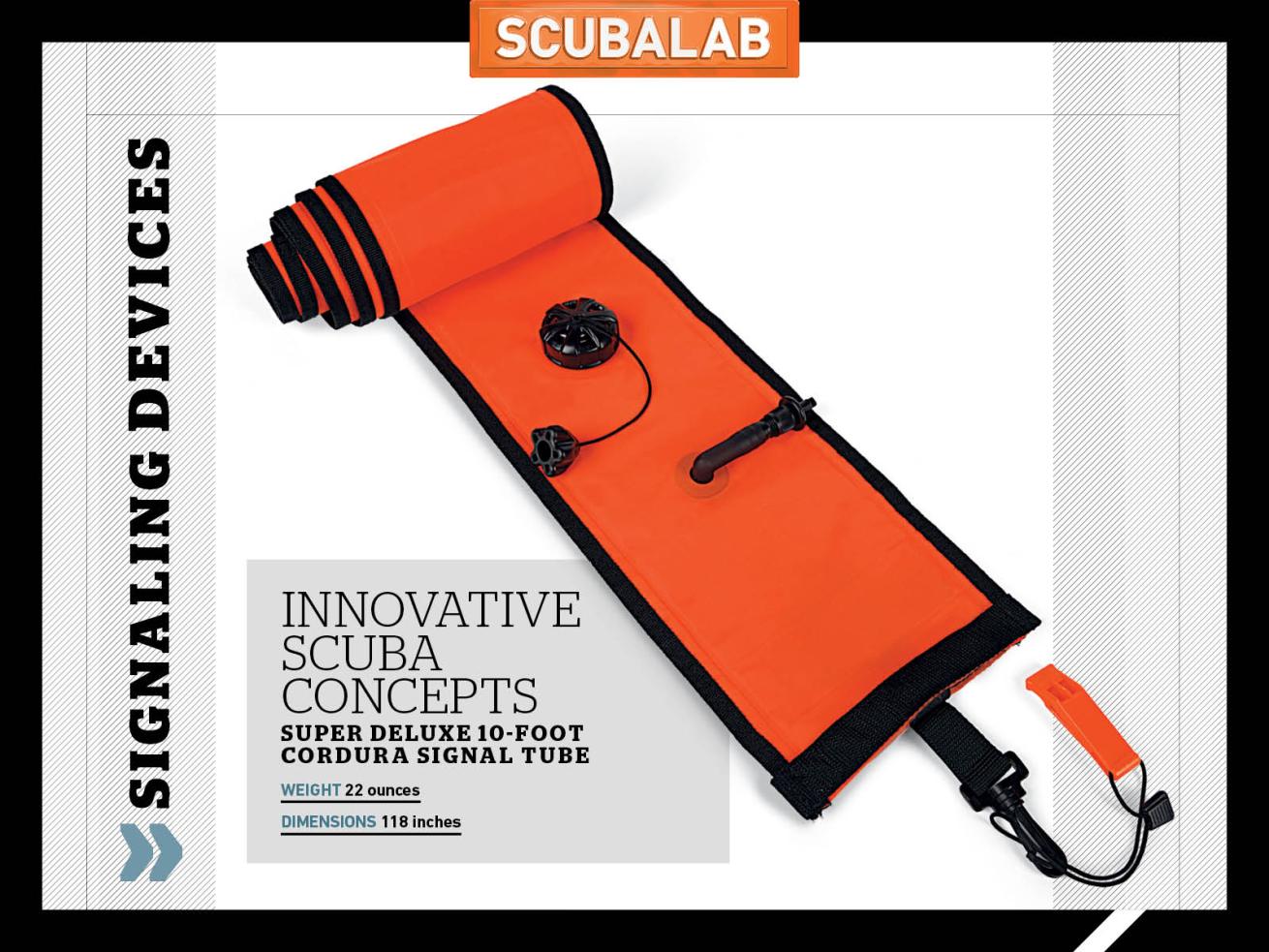
Jon WhittleInnovative Scuba Concepts Super Deluxe 10-Foot Cordura Signal Tube
When it comes to being seen, bigger is better — and few get as big as this 10-foot SMB from Innovative Scuba Concepts.
Yes, this SMB is big; spread out uninflated on the beach, it looks like a giant sea creature. But big works. From a mile away, this was the most visible of all the SMBs we tested. Still, as our test notes stated: “It would not be easy to spot with the naked eye in these conditions at this distance.” But at a half-mile, it was easily visible. Stowed, it’s surprisingly not much bigger than most 6-footers. It takes a few seconds to fi ll with the power inflator; with the oral inflator, it’s like blowing up a parade balloon. There are no reflectors, but there is a mount near the top to hang a light tube.
Differences To Keep In Mind About Emergency Lights and Strobes
Different kinds of lights can provide different benefits. While you can use many photo lights or dive lights in a pinch, it's important to understand how they differ from one another and what considerations you need to keep in mind while using them as signaling devices.
Photo lights have powerful beams and brilliant strobes. But if you’re using your imaging light during your dive, don’t consider it a safe primary for emergency use. With many video lights, an hour of dive time on high power will use up most of the battery.
Flashing lights in our test weren’t necessarily more visible than steady lights, but a flash mode dramatically increases battery life. Among lights we have evaluated, in this test and others, lights that burn at full power for an hour will routinely flash for 15 to 20 hours.
Narrow-beam lights were more visible in daylight than lights with 360-degree beams — but only when pointed toward the observer. A very narrow beam may require moving the light continually. Our experience suggested that an effective combination would be a bright light of any beam angle deployed with a large SMB with substantial reflective material.
Tektite Strobe 3500
Price: $89.95 | Contact: tek-tite.com
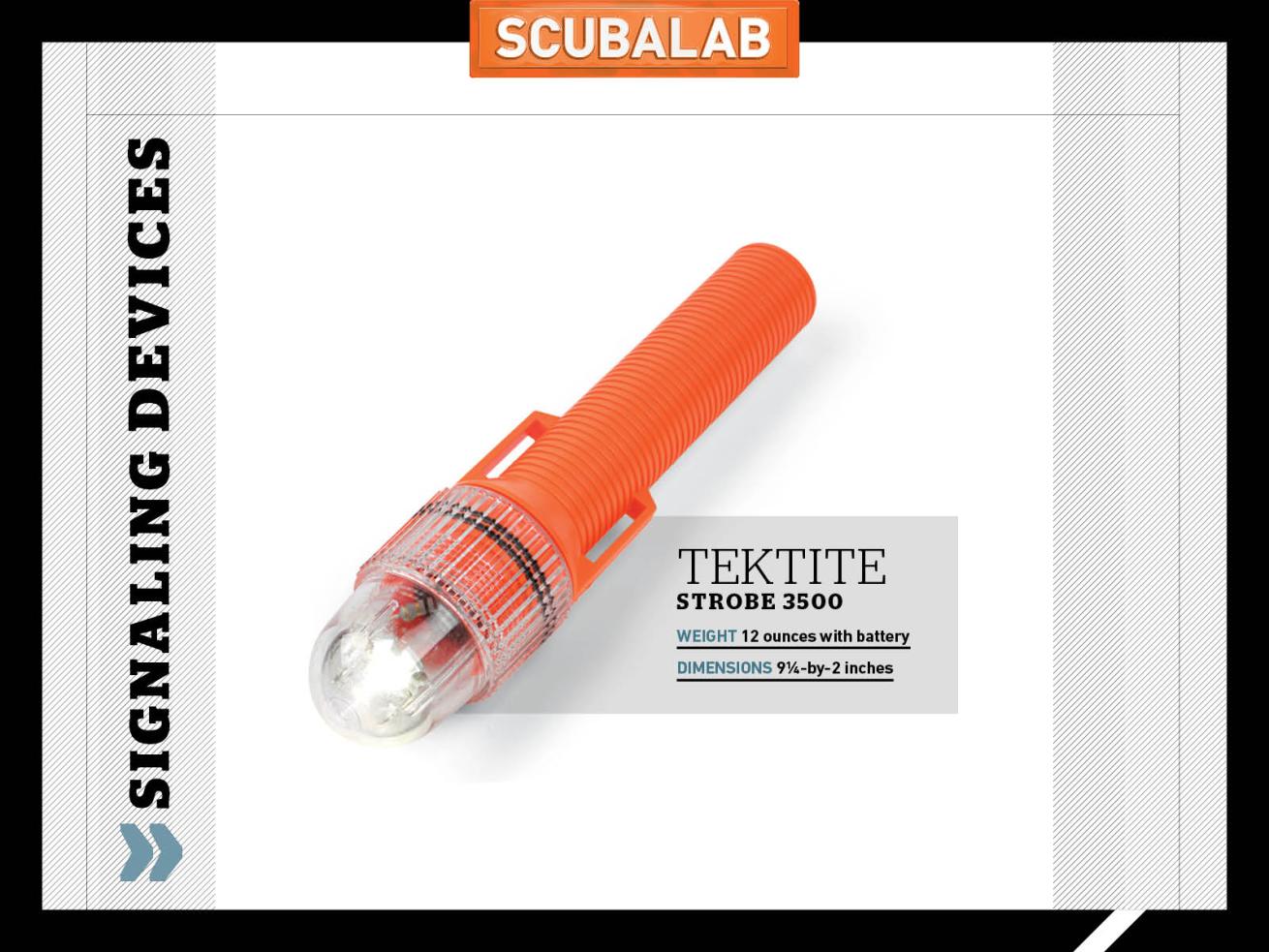
Jon WhittleTektite Strobe 3500
This emergency strobe by Tektite has a full 360-degree coverage so scuba divers don't need to worry about aiming it.
While the dive lights we tested had 15-and 120-degree beams, this strobe has full 360-degree coverage — basically horizon to horizon — so there’s no aiming required. With its considerable light output spread so wide, the Tektite’s beam was less visible in daylight than the more-concentrated dive lights. But by dusk, the insistent twice-per-second strobe was clearly visible a mile away, and rapidly became brighter as the sun set. Rated to 500 feet, it’s too heavy to mount to the top of the SMBs we tested, but it has strap loops for easy attachment to a BC. Tektite says the three C batteries burn for 100 hours on flash; ours was still going like new after 70 hours.
SeaLife Sea Dragon Mini 650
Price: $159 | Contact: sealife-cameras.com
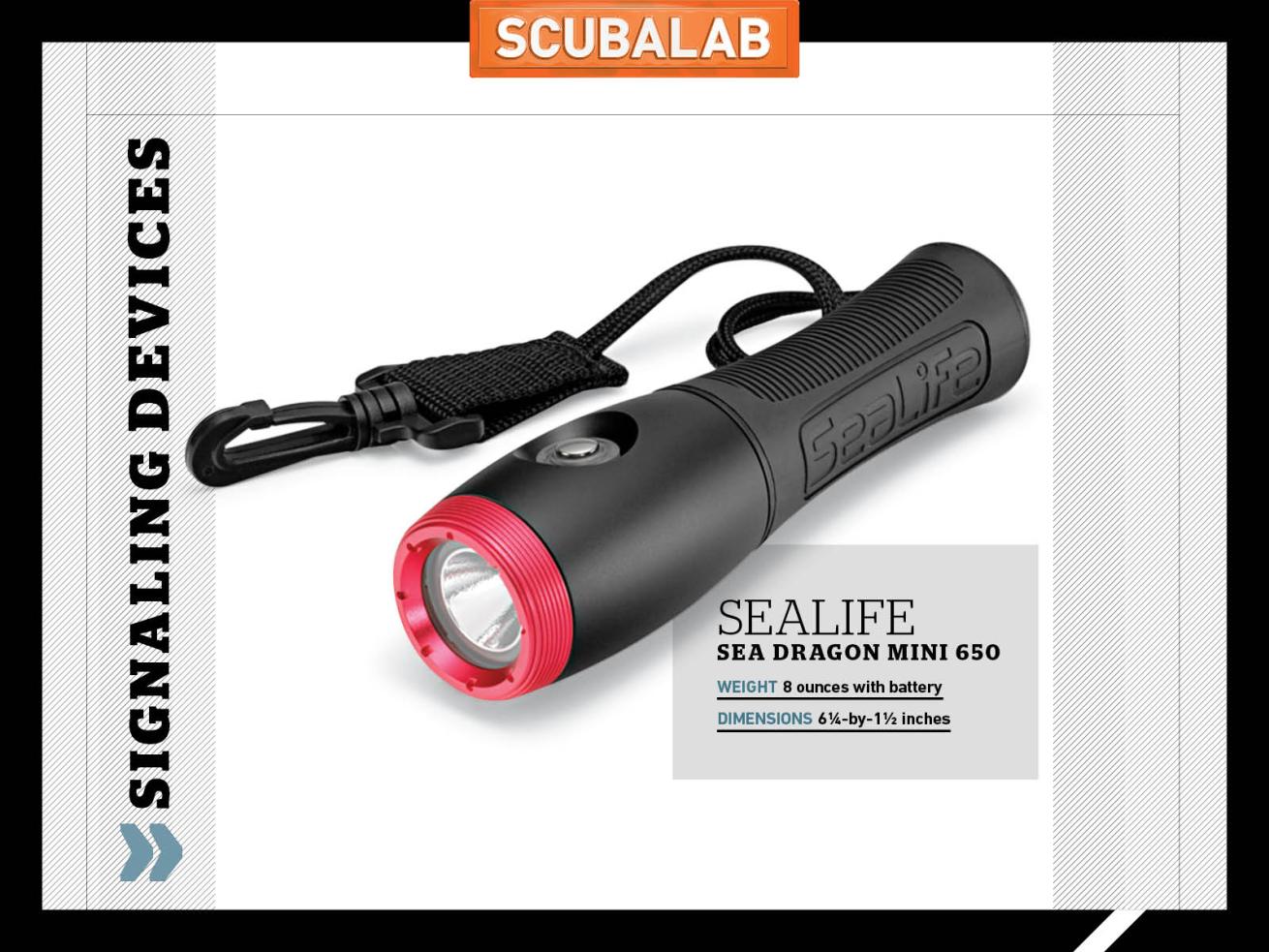
Jon WhittleSeaLife Sea Dragon Mini 650
If you find yourself adrift after dark a powerful compact dive light, like SeaLife's Sea Dragon Mini 650, can be a real life saver.
Our test underscored the importance of carrying a powerful compact light with an emergency flash. Powerful enough for primary work, the 650 is small enough to fit in any pocket and has a once-per-second flash mode. The Mini 650 we tested was the flood version with a 120-degree beam (there’s also a spot model with a 15-degree beam). An hour before sunset, the beam wasn’t visible from a mile away, hidden in the bright glare and sea-surface haze. But by 15 minutes before sunset, the beam was clearly visible, and by sunset it was impossible to miss even from a mile away.
Trident Fold-Up Divers Alert Flag
Price: $25.95 | Contact: leisurepro.com
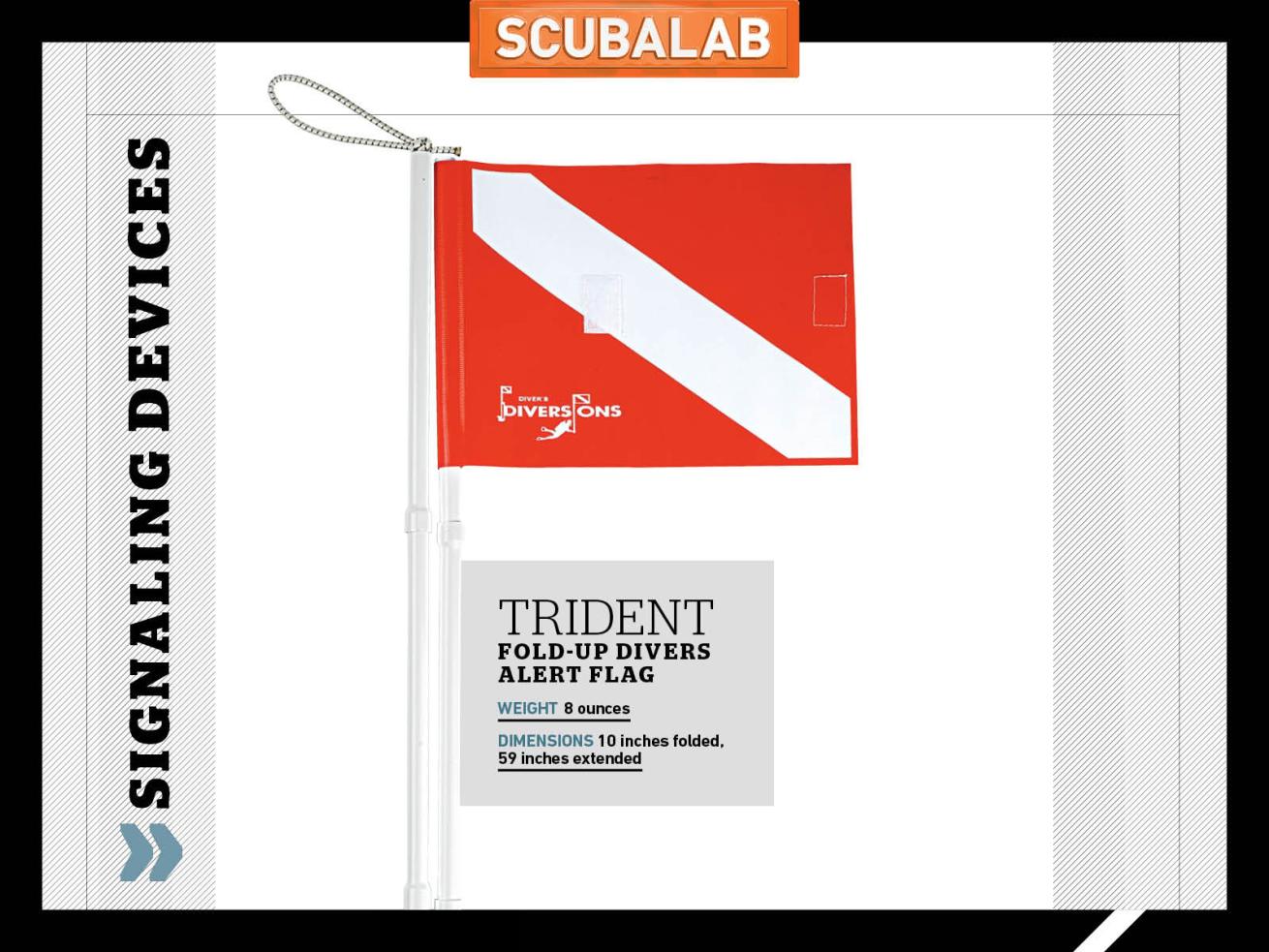
Jon WhittleTrident Fold-Up Divers Alert Flag
This collapsible Divers Alert Flag can easily be stowed in a BC pocket or D-ring and kept out of the way when it is not needed.
Made of six sections of plastic tubing bungeed together like a tent pole, it springs together when opened. Folded up, it fits in a (big) BC pocket or can be clipped to a D-ring. Pluses: It won’t leak; there’s nothing to corrode; and it’s easy to wave around. Minuses: It can’t be deployed from a safe depth underwater; it won’t provide emergency flotation like an inflatable; and you pretty much need to hold it up while it’s in use. But its biggest weakness in our test was that the 8-by-11 flag is simply too small. It was invisible at a mile, barely visible at a half mile — more so from light reflecting off the pole than the flag itself.
DAN Signaling Sausage
Price: $80 | Contact: dan.org/store
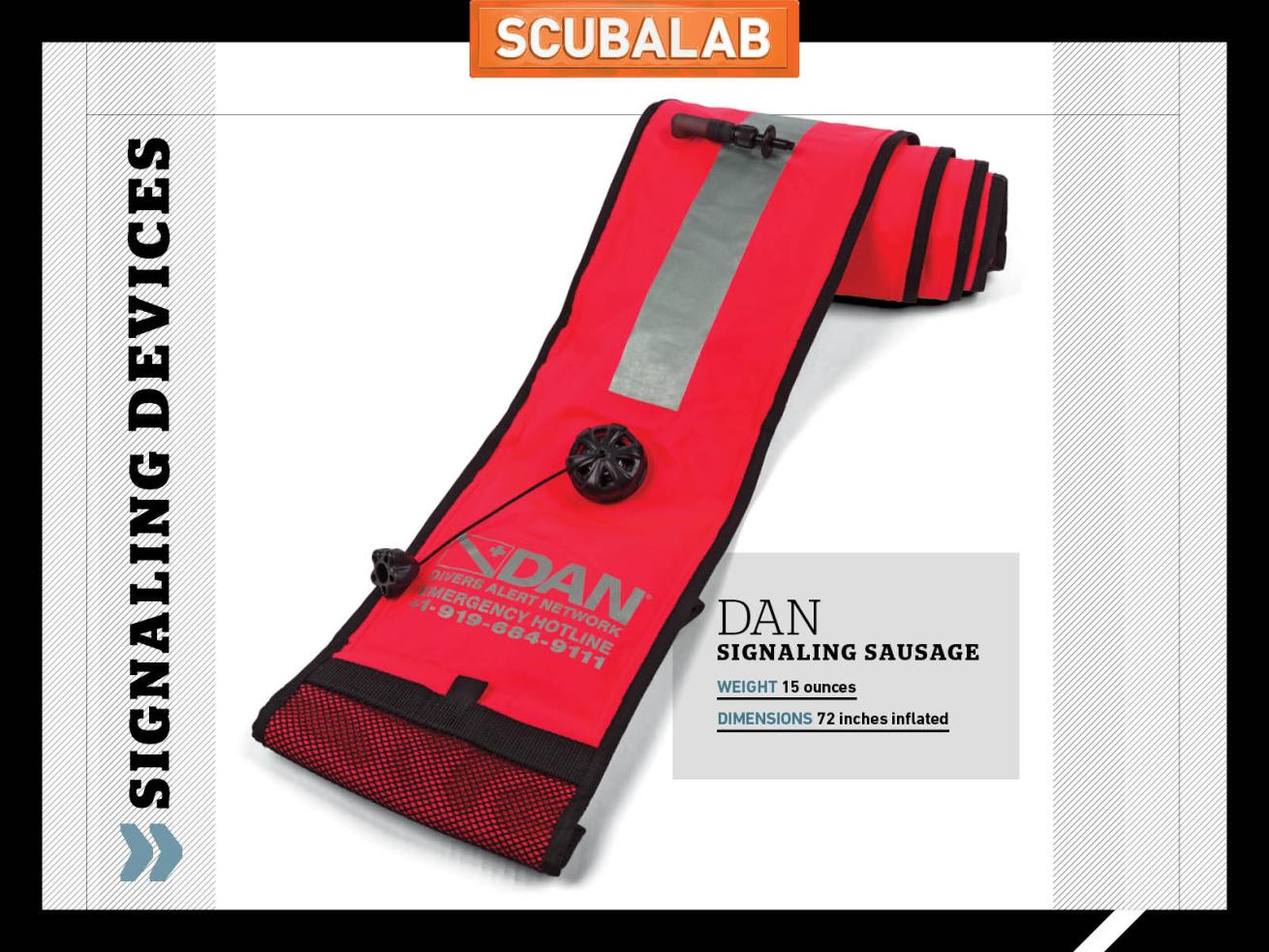
Jon WhittleDAN Signaling Sausage
Bright orange and nearly 8 inches wide, this tube was visible from a mile away in our test, but it wasn’t easy to spot. Our test notes say, “Just barely can make out with the naked eye.” From a half-mile it was much easier to pick out, partly because the 2-inch-wide vertical reflective strip that runs 4½ feet up the front and back sides of the SMB were flashing in the sun. It’s a little bulkier than some other SMBs that are about the same length because there’s a radar reflector material sewn inside the tube. DAN says the reflector can be spotted by a radar-equipped vessel from ⅓ mile away. The tube has a 3½-by-7-inch mesh pouch with hook-and-loop seal at the bottom that can hold emergency supplies like a light and mirror.
DAN Surface Signal Kit
Price: $80 (includes signaling mirror shown below, 6-foot SMB, safety light and Fox40 whistle) | Contact: dan.org/store
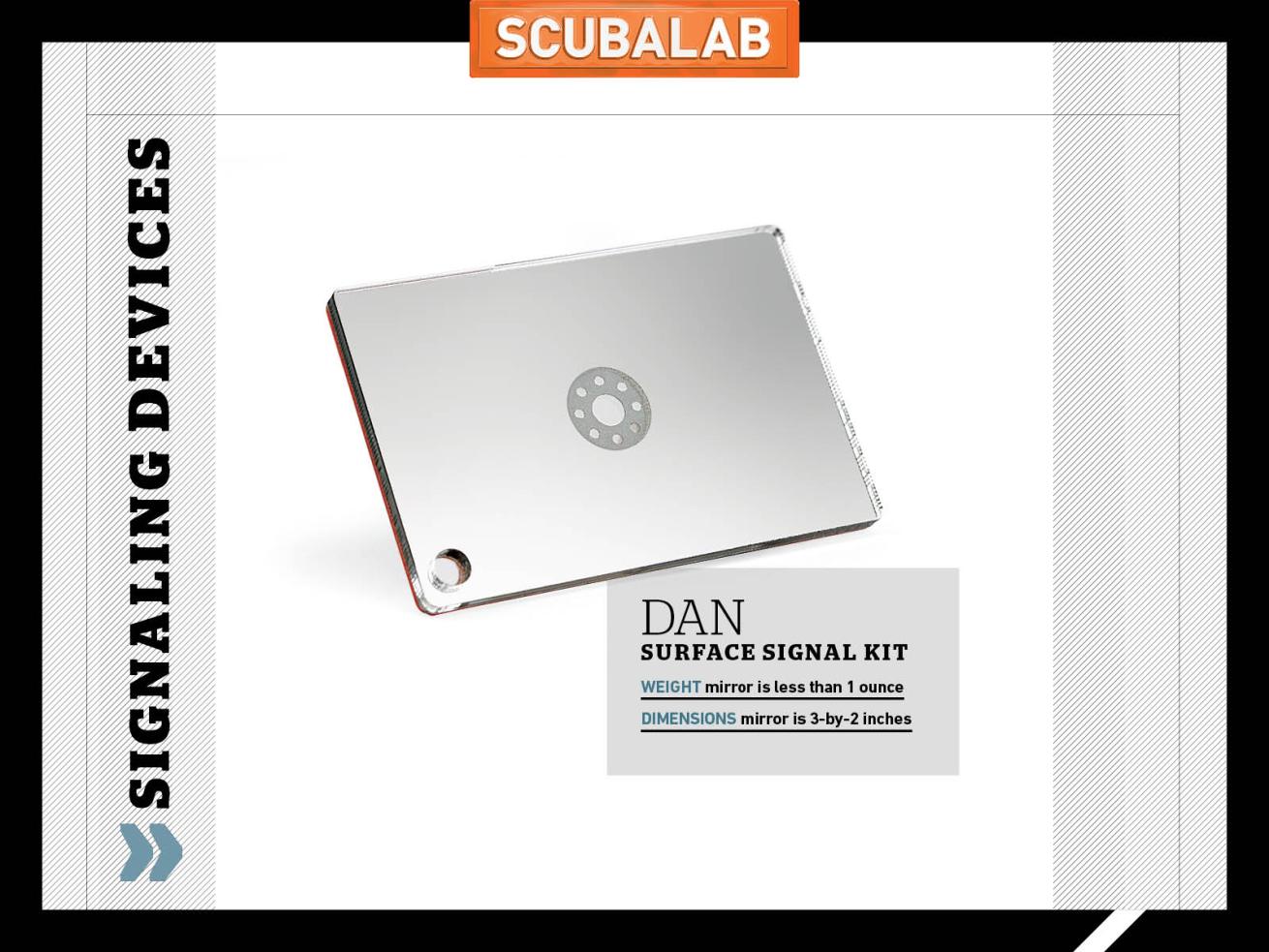
Jon WhittleDAN Surface Signal Kit
Divers carry signal mirrors for the same reason WWII pilots and early astronauts did: They’re as compact as a credit card, have no batteries or moving parts, and can attract attention from miles away. The mirror we tested, available as part of DAN’s Surface Signal Kit, has a small aiming hole in the middle that helps get the reflected flash heading in the right direction. The mirror is an attention-getter in bright sun, impossible to miss from a mile away. It also demonstrated why a famous Life magazine photo shows Mercury astronauts in survival rafts training to use their mirrors: Getting that flash where you want it takes practice, especially if you’re aiming it at a distant target. DAN’s mirror has a hole in the corner to mount to a lanyard, and has instructions for using it printed on the back. If you’re going to carry a signal mirror, take the time to become proficient with it before you need to use it.
Tektite Mark-Lite Strobe
Price: $59.95 | Contact: tek-tite.com
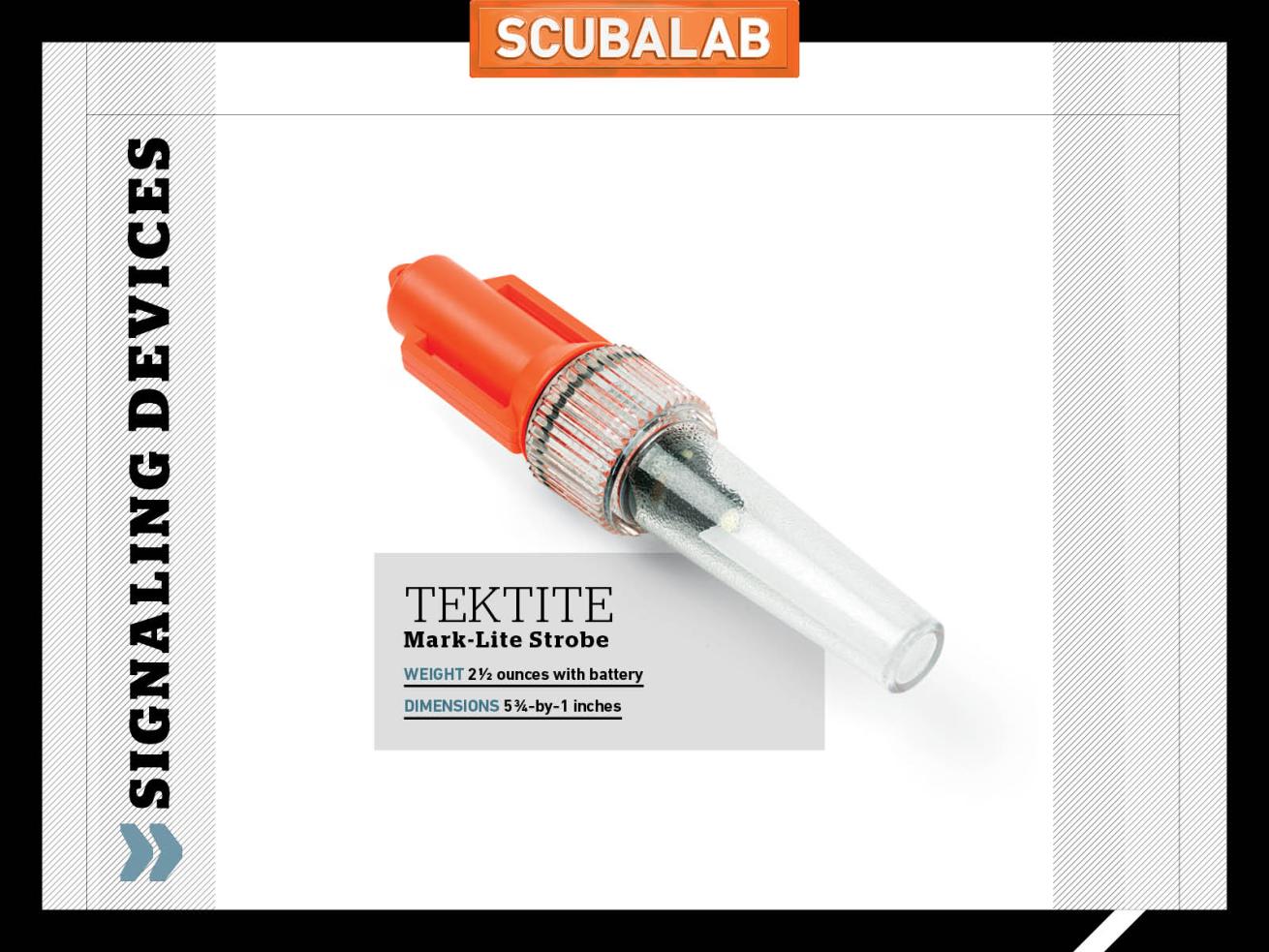
Jon WhittleTektite Mark-Lite Strobe
The Tektite Mark-Lite Strobe is a small emergency light that can be attached to your BC or to the top of an SMB with a twice-per-second flash.
The little Mark-Lite is a scaled-down version of the 3500 strobe with the same 360-degree beam and twice-per-second flash. It’s small enough to easily attach to the top of an SMB, or could be fastened to a BC or even a mask strap with the included hook-and-loop strap and mounting slots. The 360-degree beam wasn’t really visible until the sun was low, when it became surprisingly bright given its size (thanks to the reflector mounted inside the lens cover, which adds nearly 2 inches to its length but boosts visibility). The Mark-Lite switches on and off by twisting the head. It’s ruggedly built and rated waterproof to 1,000 feet. Ours burned for more than 12 hours with an inexpensive alkaline AA; Tektite says a lithium-ion AA will last for 20 hours.
DiveAlert SSMB Deluxe
Price: $56 | Contact: divealert.com
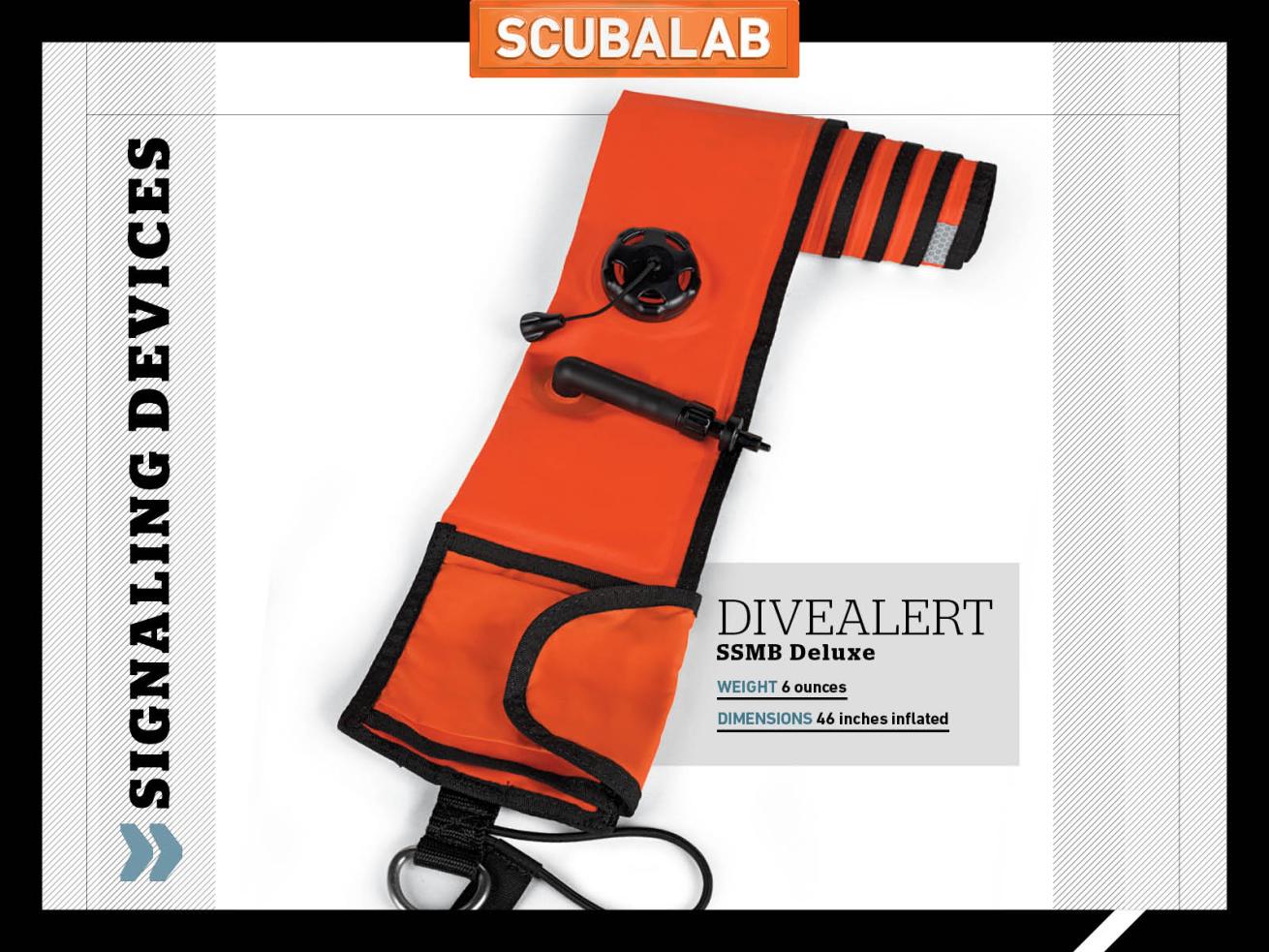
Jon WhittleDiveAlert SSMB Deluxe
This bright orange SSMB from DiveAlert has strips of reflective material and is small enough that you can hold it in one hand and wave it over your head.
The smallest SMB we tested at 46 inches long and about 4½ inches wide when inflated, this is comparable in size to those we commonly see in use on dive boats, and stows very compactly. From a full mile away, we were unable to spot it at all with the naked eye. From a half-mile, we could just barely pick it out, but it was much less visible than the next-larger SMB here, in part because it’s narrower as well as shorter. That makes it easy to hold in one hand to wave over your head — something you can’t do with the really jumbo SMBs. But in our test conditions, even with the diver waving briskly, it was tough to see at a half-mile, despite the bright orange color and strips of reflective material at the top on front and back.
Expert Advice
We asked Coast Guard Lt. Matthew Winter – a diver and command dive officer for the Maritime Safety & Security Team in San Diego – what divers should do to prepare for lost-at-sea emergencies.
You’re harder to find if no one knows when or where to look
“We say this a lot because it’s really important: Plan your dive, dive your plan and make sure somebody on shore knows when you’re supposed to be back.”
Plan your dive with an eye toward all contingencies
“As part of the planning phase before each dive, divers need to evaluate more than just depths and bottom times, but the hazards they may face and their plan for overcoming them. Understanding these hazards will help the divers make more informed decisions on what safety equipment is appropriate and not burden themselves with what is not.”
An emergency is no time to learn how to use your signaling gear
“It’s important to be really familiar with any gear you’re using before you need it in an emergency. You don’t want to be reading the instructions on the back of your signaling mirror for the first time when you’re bobbing in the surf, or trying to figure out how to turn on your light’s SOS flash in the dark.”

